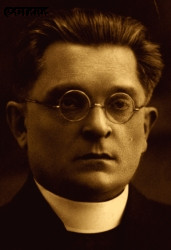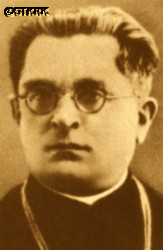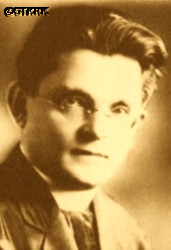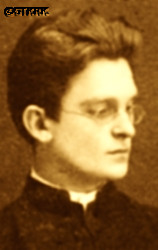Roman Catholic
St Sigismund parish
05-507 Słomczyn
85 Wiślana Str.
Konstancin deanery
Warsaw archdiocese, Poland
full list:
displayClick to display full list

searchClick to search full list by categories
wyświetlKliknij by wyświetlić pełną listę po polsku

szukajKliknij by przeszukać listę wg kategorii po polsku

Martyrology of the clergy — Poland
XX century (1914 – 1989)
personal data
religious status
Servant of God
surname
KEMĖŠIS
forename(s)
Fabian
forename(s)
versions/aliases
Fabijonas
function
diocesan priest
creed
Latin (Roman Catholic) Church RCmore on
en.wikipedia.org
[access: 2014.09.21]
diocese / province
Poniewież diocesemore on
en.wikipedia.org
[access: 2017.11.07]
academic distinctions
Doctor of Philosophy
honorary titles
honorary canonmore on
honorary canon
(St Peter and St Paul the Apostles RC cathedral church, Kaunastoday: Kaunas city dist., Kaunas Cou., Lithuania
more on
en.wikipedia.org
[access: 2022.06.29])
nationality
Lithuanian
date and place
of death
21.01.1954

ITL SibLagGuLAG slave labour camp network
today: Mariinsk, Kemerovo oblast, Russia
more on
ru.wikipedia.org
[access: 2024.01.29]
details of death
In 1914‐1918 Lithuanian activist in United State — among others a member of Lithuanian delegation in 1917 for talks with USA president Woodrow Wilson about Lithuanian independence.
After German defeat in the World War II started by German and Russian invasion of Poland in 09.1939, after start in 1945 of Russian occupation of Lithuania forced by the Russians to abandon his ministry and lecturing in Lithuanian Academy of Agriculture in Akademija in Kėdainiai municipality.
On 11.10.1946 arrested by the Russian in his Pandėlys parish rectory.
Transported to Lukishki prison in Vilnius.
Repeatedly interrogated and tortured.
Sentenced to 10 years of slave labour in Russian concentration camps Gulag.
In 1947‐1948 held in Šilutė prison.
Next in 1948 sent to Mariinsk, the center of ITL SibLag concentration camp, in Kemerovo oblast.
There perished.
cause of death
extermination
perpetrators
Russians
sites and events
ITL SibLagClick to display the description, GulagClick to display the description, Vilnius (Łuskis Square)Click to display the description, Ribbentrop‐MolotovClick to display the description, Pius XI's encyclicalsClick to display the description
date and place
of birth
25.02.1880

Vastapaitoday: Alanta eld., Molėtai dist., Utena Cou., Lithuania
more on
lt.wikipedia.org
[access: 2020.07.31]
alt. dates and places
of birth
20.10.1878, 20.01.1879
parents
KEMĖŠIS Dominic
🞲 1854, ? — 🕆 1894, ?

ZAKARKAITĖ Barbara
🞲 1857, ? — 🕆 1944, ?
presbyter (holy orders)
ordination
01.10.1902

Kaunastoday: Kaunas city dist., Kaunas Cou., Lithuania
more on
en.wikipedia.org
[access: 2022.06.29]
St Peter and St Paul the Apostles RC cathedral churchmore on
en.wikipedia.org
[access: 2018.09.02]
positions held
1946
parish priest — Pandėlystoday: Pandėlys eld., Rokiškis dist., Panevėžys Cou., Lithuania
more on
en.wikipedia.org
[access: 2022.02.15] ⋄ RC parish ⋄ Rokiškistoday: Rokiškis urban eld., Rokiškis dist., Panevėžys Cou., Lithuania
more on
en.wikipedia.org
[access: 2020.11.27] RC deanery
1945 – 1946
parish priest — Viešintostoday: Viešintos eld., Anykščiai dist., Utena Cou., Lithuania
more on
en.wikipedia.org
[access: 2022.06.29] ⋄ St Michael the Archangel RC parish ⋄ Panevėžystoday: Panevėžys eld., Panevėžys dist., Panevėžys Cou., Lithuania
more on
en.wikipedia.org
[access: 2020.11.13] RC deanery
1942 – 1944
rector — Akademijatoday: Akademija eld., Kaunas dist., Kaunas Cou., Lithuania
more on
en.wikipedia.org
[access: 2022.07.16] ⋄ St Paul RC church (academic)
1941 – 1944
lecturer — Dotnuvatoday: Dotnuva eld., Kėdainiai dist., Kaunas Cou., Lithuania
more on
en.wikipedia.org
[access: 2022.07.16] ⋄ political economy, agricultural cooperation, English, Agricultural Academy
from 1928
dean — Dotnuvatoday: Dotnuva eld., Kėdainiai dist., Kaunas Cou., Lithuania
more on
en.wikipedia.org
[access: 2022.07.16] ⋄ Department of General Economics, Agricultural Academy
from 1928
lecturer — Dotnuvatoday: Dotnuva eld., Kėdainiai dist., Kaunas Cou., Lithuania
more on
en.wikipedia.org
[access: 2022.07.16] ⋄ economics and agricultural policy, Agricultural Academy
from 1927
professor — Dotnuvatoday: Dotnuva eld., Kėdainiai dist., Kaunas Cou., Lithuania
more on
en.wikipedia.org
[access: 2022.07.16] ⋄ Department of General Economics, Agricultural Academy
1924 – 1940
lecturer — Dotnuvatoday: Dotnuva eld., Kėdainiai dist., Kaunas Cou., Lithuania
more on
en.wikipedia.org
[access: 2022.07.16] ⋄ political economy, agricultural cooperation, English, Agricultural Academy
1924 – 1935
rector — Akademijatoday: Akademija eld., Kaunas dist., Kaunas Cou., Lithuania
more on
en.wikipedia.org
[access: 2022.07.16] ⋄ St Paul RC church (academic)
1919 – 1924
parish priest — Detroittoday: Wayne Cou., Michigan US‐MI state, United States of America
more on
en.wikipedia.org
[access: 2022.08.05] ⋄ St George RC parish
1922 – 1924
PhD student — Washingtontoday: District of Columbia US‐DC state, United States of America
more on
en.wikipedia.org
[access: 2022.07.21] ⋄ economics and pedagogy, Department of Philosophy, Catholic University of America CUA
1918 – 1919
vicar — Chicagotoday: Cook Cou., Illinois US‐IL state, United States of America
more on
en.wikipedia.org
[access: 2022.07.16] ⋄ St George RC parish
1915 – 1918
vicar — Bostontoday: Suffolk Cou., Massachusetts US‐MA state, United States of America
more on
en.wikipedia.org
[access: 2022.07.16] ⋄ St Peter RC parish (Lithuanian)
1914 – 1915
vicar — Chicagotoday: Cook Cou., Illinois US‐IL state, United States of America
more on
en.wikipedia.org
[access: 2022.07.16] ⋄ RC parish (Lithuanian)
1917 – 1918
student — Chicagotoday: Cook Cou., Illinois US‐IL state, United States of America
more on
en.wikipedia.org
[access: 2022.07.16] ⋄ sociology, Loyola University
till 1922
editor — (United States of America territory)today: United States of America
more on
en.wikipedia.org
[access: 2022.08.05] ⋄ magazines — i.a. „Draugas” („Friend”), „Darbininkas” („Worker”), „Pažanga” („Progress”)
1913 – 1914
vicar — Glasgowtoday: Glasgow City Cou., Scotland, United Kingdom
more on
en.wikipedia.org
[access: 2022.06.29] ⋄ St Casimir RC parish
1913 – 1914
editor — (Scotland territory)today: Scotland, United Kingdom
more on
en.wikipedia.org
[access: 2020.07.31] ⋄ magazine, „Išeivių draugą” (Eng. „Friends of the Elders” square)
1911 – 1913
vicar — Vilniustoday: Vilnius city dist., Vilnius Cou., Lithuania
more on
en.wikipedia.org
[access: 2022.01.06] ⋄ St Nicholas the Bishop and Confessor RC parish ⋄ Vilniustoday: Vilnius city dist., Vilnius Cou., Lithuania
more on
en.wikipedia.org
[access: 2022.01.06] RC deanery
1911 – 1913
editor — Vilniustoday: Vilnius city dist., Vilnius Cou., Lithuania
more on
en.wikipedia.org
[access: 2022.01.06] ⋄ magazine, „Viltį” (Eng. „Hope”)
1909 – 1911
vicar — Vabalninkastoday: Vabalninkas eld., Biržai dist., Panevėžys Cou., Lithuania
more on
en.wikipedia.org
[access: 2022.06.29] ⋄ Assumption of the Blessed Virgin Mary RC parish ⋄ Biržaitoday: Biržai urban eld., Biržai dist., Panevėžys Cou., Lithuania
more on
en.wikipedia.org
[access: 2022.06.29] RC deanery
1907 – 1909
vicar — Subačiustoday: Subačius eld., Kupiškis dist., Panevėžys Cou., Lithuania
more on
en.wikipedia.org
[access: 2022.01.09] ⋄ RC parish ⋄ Kupiškistoday: Kupiškis eld., Kupiškis dist., Panevėžys Cou., Lithuania
more on
en.wikipedia.org
[access: 2022.01.09] RC deanery
1902 – 1907
vicar — Tauragėtoday: Tauragė urban eld., Tauragė dist., Tauragė Cou., Lithuania
more on
en.wikipedia.org
[access: 2022.06.29] ⋄ RC parish ⋄ Tauragėtoday: Tauragė urban eld., Tauragė dist., Tauragė Cou., Lithuania
more on
en.wikipedia.org
[access: 2022.06.29] RC deanery
1897 – 1902
student — Kaunastoday: Kaunas city dist., Kaunas Cou., Lithuania
more on
en.wikipedia.org
[access: 2022.06.29] ⋄ philosophy and theology, Theological Seminary
others related
in death
PIOTROWSKIClick to display biography Leo
sites and events
descriptions
ITL SibLag: Russian Rus. Исправи́тельно‐Трудово́й Ла́герь (Eng. Corrective Labor Camp) ITL Rus. Сибирский (Eng. Siberian) — concentration and slave forced labor camp (within the Gulag complex) — headquartered in Mariinsk in Kemerovo Oblast, where a central camp for invalids was also operational (moved twice to Novosibirsk, c. 350 km away). Founded in 1929. One of the largest — initially spread over large area from Omsk to Krasnoiarsk, as a matter of fact whole Western Siberian Plain, next subdivided and limited to Novosibirsk, Tomsk and Kemerovo oblasts. Up to 80,000 inmates were held in SibLag: e.g. 78,838 (01.01.1938); 77,919 (01.01.1942); 70,370 (01.04.1942). Prisoners slaved at railroad construction, forestry, carpentry and in coal mines, and other industrial branches (brick, clothing, leather and fur factories and plants). Closed down in c. 1960. (more on: tspace.library.utoronto.caClick to attempt to display webpage
[access: 2018.09.02], www.gulagmuseum.orgClick to attempt to display webpage
[access: 2014.05.09])
Gulag: The acronym Gulag comes from the Rus. Главное управление исправительно‐трудовых лагерей и колоний (Eng. Main Board of Correctional Labor Camps). The network of Russian concentration camps for slave labor was formally established by the decision of the highest Russian authorities on 27.06.1929. Control was taken over by the OGPU, the predecessor of the genocidal NKVD (from 1934) and the MGB (from 1946). Individual gulags (camps) were often established in remote, sparsely populated areas, where industrial or transport facilities important for the Russian state were built. They were modeled on the first „great construction of communism”, the White Sea‐Baltic Canal (1931‐1932), and Naftali Frenkel, of Jewish origin, is considered the creator of the system of using forced slave labor within the Gulag. He went down in history as the author of the principle „We have to squeeze everything out of the prisoner in the first three months — then nothing is there for us”. He was to be the creator, according to Alexander Solzhenitsyn, of the so‐called „Boiler system”, i.e. the dependence of food rations on working out a certain percentage of the norm. The term ZEK — prisoner — i.e. Rus. заключенный‐каналоармец (Eng. canal soldier) — was coined in the ITL BelBaltLag managed by him, and was adopted to mean a prisoner in Russian slave labor camps. Up to 12 mln prisoners were held in Gulag camps at one time, i.e. c. 5% of Russia's population. In his book „The Gulag Archipelago”, Solzhenitsyn estimated that c. 60 mln people were killed in the Gulag until 1956. Formally dissolved on 20.01.1960. (more on: en.wikipedia.orgClick to attempt to display webpage
[access: 2024.04.08])
Vilnius (Łuskis Square): In the former Tsarist prison and 1918‐1939 Polish Republic voivodeship buildings at Łukiski Square (Ofiarna Str.) Germans in 1941 set up the Gestapo HQ and jail and Russians in 1944 the Vilnius HQ of the genocidal NKVD/MGB organisation. Thousands of Polish soldiers of resistance Home Army AK (part of Polish Clandestine State), Lithuanian partisans and during Russian occupation after 1944 — German collaborators were interrogated and tortured there. In the basements death sentences were carried out. In 1944‐1960 alone Russians carried out more then 1,000 death sentences there — some of the bodies were secretely buried in a nearby Tuskulanum palace in Vilnius. (more on: en.wikipedia.orgClick to attempt to display webpage
[access: 2017.06.16])
Ribbentrop‐Molotov: Genocidal Russian‐German alliance pact between Russian leader Joseph Stalin and German leader Adolf Hitler signed on 23.08.1939 in Moscow by respective foreign ministers, Mr. Vyacheslav Molotov for Russia and Joachim von Ribbentrop for Germany. The pact sanctioned and was the direct cause of joint Russian and German invasion of Poland and the outbreak of the World War II in 09.1939. In a political sense, the pact was an attempt to restore the status quo ante before 1914, with one exception, namely the „commercial” exchange of the so‐called „Kingdom of Poland”, which in 1914 was part of the Russian Empire, fore Eastern Galicia (today's western Ukraine), in 1914 belonging to the Austro‐Hungarian Empire. Galicia, including Lviv, was to be taken over by the Russians, the „Kingdom of Poland” — under the name of the General Governorate — Germany. The resultant „war was one of the greatest calamities and dramas of humanity in history, for two atheistic and anti‐Christian ideologies — national and international socialism — rejected God and His fifth Decalogue commandment: Thou shall not kill!” (Abp Stanislav Gądecki, 01.09.2019). The decisions taken — backed up by the betrayal of the formal allies of Poland, France and Germany, which on 12.09.1939, at a joint conference in Abbeville, decided not to provide aid to attacked Poland and not to take military action against Germany (a clear breach of treaty obligations with Poland) — were on 28.09.1939 slightly altered and made more precise when a treaty on „German‐Russian boundaries and friendship” was agreed by the same murderous signatories. One of its findings was establishment of spheres of influence in Central and Eastern Europe and in consequence IV partition of Poland. In one of its secret annexes agreed, that: „the Signatories will not tolerate on its respective territories any Polish propaganda that affects the territory of the other Side. On their respective territories they will suppress all such propaganda and inform each other of the measures taken to accomplish it”. The agreements resulted in a series of meeting between two genocidal organization representing both sides — German Gestapo and Russian NKVD when coordination of efforts to exterminate Polish intelligentsia and Polish leading classes (in Germany called «Intelligenzaktion», in Russia took the form of Katyń massacres) where discussed. Resulted in deaths of hundreds of thousands of Polish intelligentsia, including thousands of priests presented here, and tens of millions of ordinary people,. The results of this Russian‐German pact lasted till 1989 and are still in evidence even today. (more on: en.wikipedia.orgClick to attempt to display webpage
[access: 2015.09.30])
Pius XI's encyclicals: Facing the creation of two totalitarian systems in Europe, which seemed to compete with each other, though there were more similarities than contradictions between them, Pope Pius XI issued in 03.1937 (within 5 days) two encyclicals. In the „Mit brennender Sorge” (Eng. „With Burning Concern”) published on 14.03.1938, condemned the national socialism prevailing in Germany. The Pope wrote: „Whoever, following the old Germanic‐pre‐Christian beliefs, puts various impersonal fate in the place of a personal God, denies the wisdom of God and Providence […], whoever exalts earthly values: race or nation, or state, or state system, representatives of state power or other fundamental values of human society, […] and makes them the highest standard of all values, including religious ones, and idolizes them, this one […] is far from true faith in God and from a worldview corresponding to such faith”. On 19.03.1937, published „Divini Redemptoris” (Eng. „Divine Redeemer”), in which criticized Russian communism, dialectical materialism and the class struggle theory. The Pope wrote: „Communism deprives man of freedom, and therefore the spiritual basis of all life norms. It deprives the human person of all his dignity and any moral support with which he could resist the onslaught of blind passions […] This is the new gospel that Bolshevik and godless communism preaches as a message of salvation and redemption of humanity”… Pius XI demanded that the established human law be subjected to the natural law of God , recommended the implementation of the ideal of a Christian state and society, and called on Catholics to resist. Two years later, National Socialist Germany and Communist Russia came together and started World War II. (more on: www.vatican.vaClick to attempt to display webpage
[access: 2023.05.28], www.vatican.vaClick to attempt to display webpage
[access: 2023.05.28])
sources
personal:
newsaints.faithweb.comClick to attempt to display webpage
[access: 2021.12.19], lt.wikipedia.orgClick to attempt to display webpage
[access: 2018.09.02], www.anykstenai.ltClick to attempt to display webpage
[access: 2018.09.02]
original images:
parodos.mab.ltClick to attempt to display webpage
[access: 2018.09.02], www.partizanai.orgClick to attempt to display webpage
[access: 2018.09.02], lt1918.ltClick to attempt to display webpage
[access: 2018.09.02], commons.wikimedia.orgClick to attempt to display webpage
[access: 2018.09.02], cmentarznarossie.uksw.edu.plClick to attempt to display webpage
[access: 2025.03.20], ipn.gov.plClick to attempt to display webpage
[access: 2019.02.02]
LETTER to CUSTODIAN/ADMINISTRATOR
If you have an Email client on your communicator/computer — such as Mozilla Thunderbird, Windows Mail or Microsoft Outlook, described at WikipediaPatrz:
en.wikipedia.org, among others — try the link below, please:
LETTER to CUSTODIAN/ADMINISTRATORClick and try to call your own Email client
If however you do not run such a client or the above link is not active please send an email to the Custodian/Administrator using your account — in your customary email/correspondence engine — at the following address:

giving the following as the subject:
MARTYROLOGY: KEMĖŠIS Fabian
To return to the biography press below:
 Click to return to biography
Click to return to biography













